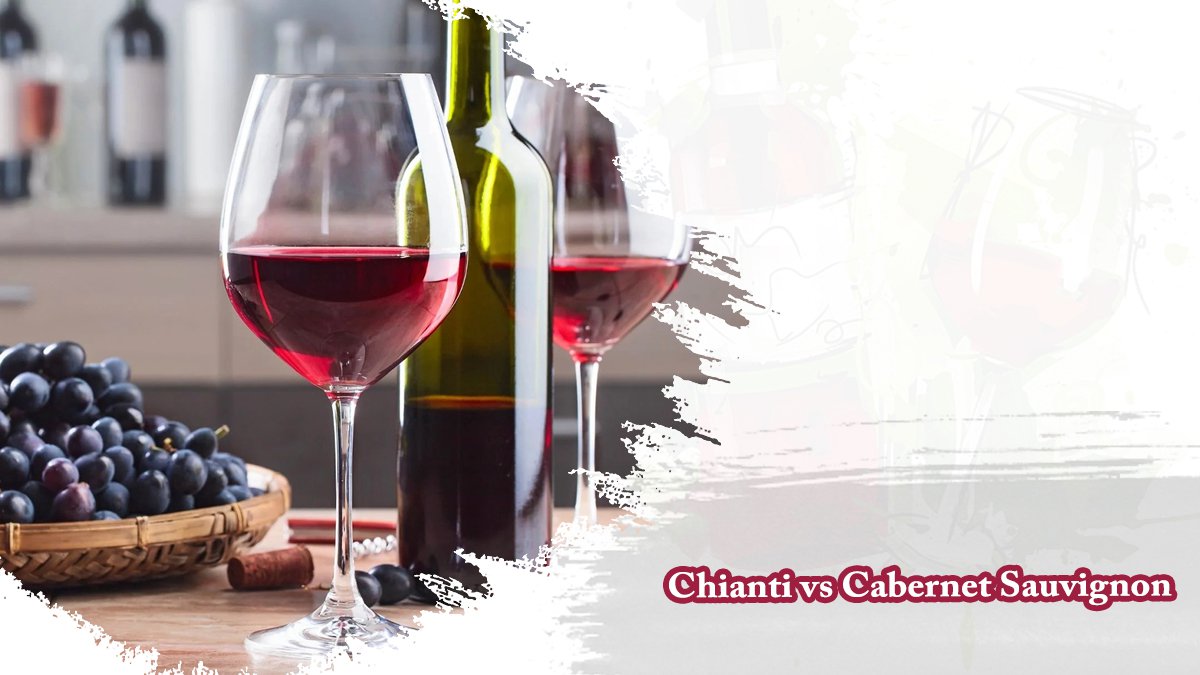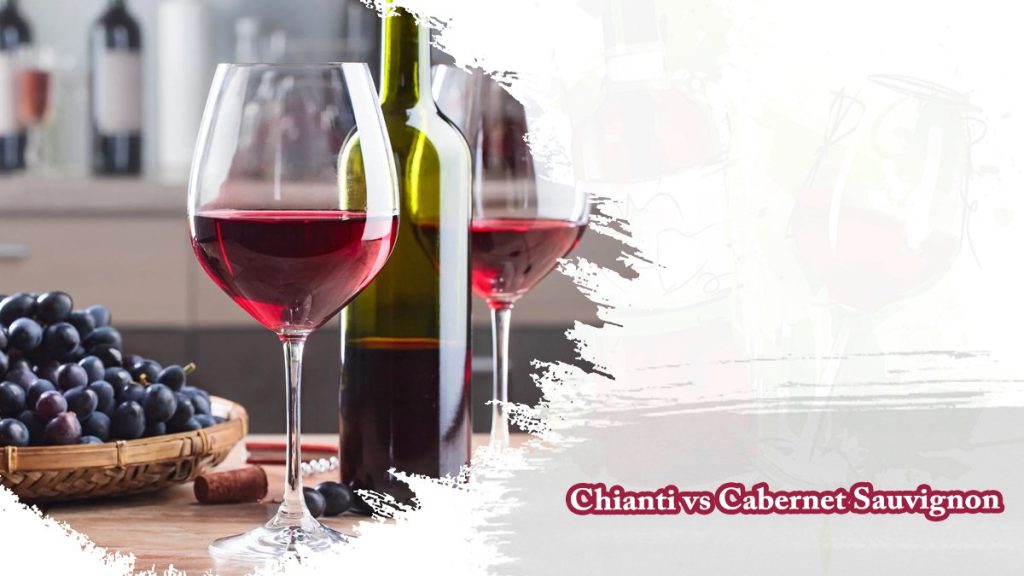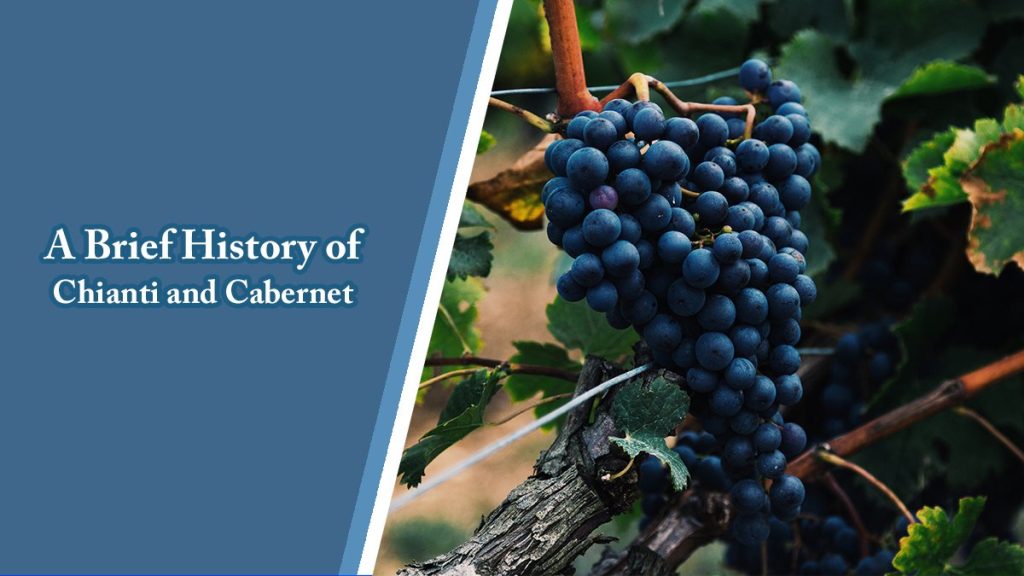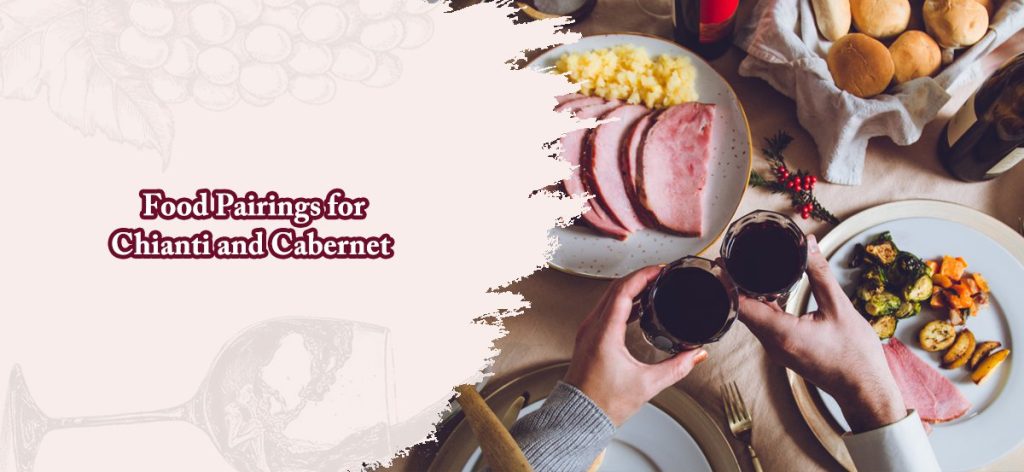Chianti vs Cabernet Sauvignon
There are few things as gratifying as a well-deserved glass of wine at the end of a long day. And it’s no secret that the world of wine can be intimidating, as there seems to be a never-ending multitude of options for enthusiasts to explore.
However, you can hardly consider yourself a wine lover without diving into the wondrous realms of Chianti vs Cabernet – two of the most iconic and beloved wines in the world. These two titans of the wine world have captivated the hearts and palates of millions of aficionados worldwide and for good reason. They each have an illustrious history, a unique flavor profile, and a story worthy of telling.
But what exactly are the primary differences between Chianti and Cabernet? If you’re trying to decide between two heavyweights – Chianti and Cabernet Sauvignon – this blog post is here to help! Here we’ll examine both wines in depth, exploring their origins, flavors, characteristics, and more. We’ll discuss how they pair with food as well as what occasions they are best suited for.
Whether you prefer robust reds or lighter-bodied wines, by the end of this article you should have all the knowledge necessary to choose either Chianti or Cabernet Sauvignon confidently based on your preferences. So let’s pour a glass and get started learning about these dueling varietals!
Overview of Chianti vs Cabernet Sauvignon
Wine enthusiasts know that choosing the right wine is more than just picking a bottle off the shelf. Different grape varietals, regions, and winemaking styles influence the flavor, aroma, and color of the wine. Two popular wine types, Chianti and Cabernet, are often compared for their distinct characteristics.
Chianti is a red wine made from the Sangiovese grape, which mainly grows in the Chianti region of Tuscany, Italy. It is known for its fruity and floral aroma, high acidity, and tart taste. Chianti traditionally pairs well with tomato-based sauces, grilled meats, and hard cheeses. Some wine producers blend other grape varietals into the Sangiovese to add complexity to the wine. For example, a Chianti Classico Riserva must have a minimum of 80% Sangiovese and can contain up to 20% of other grapes such as Canaiolo, Colorino, or Cabernet Sauvignon.
On the other hand, Cabernet is a red wine made from the Cabernet Sauvignon grape, which is widely cultivated in many wine regions around the world. It is known for its dark color, full body, tannins, and complex flavors of black currants, blackberries, and cedar. Cabernet pairs well with red meats, game, and strong cheeses. Unlike Chianti which should be consumed within a few years, Cabernet can age well for decades, becoming smoother and more mellow over time.
When it comes to winemaking, both Chianti and Cabernet can undergo different processes that affect their taste and style. For example, some Chianti producers use oak barrels to age the wine, which can impart flavors of vanilla and spice. Others use cement or steel tanks to preserve the natural fruitiness of the Sangiovese grape. Cabernet producers typically use oak barrels to age the wine, which can give it a smoky, toasted flavor. Some Cabernet producers blend other grapes such as Merlot or Cabernet Franc to soften the wine’s tannins and add depth.
Chianti and Cabernet are two distinct red wines that offer different taste profiles and food pairings. Chianti is known for its fruity aroma, high acidity, and affordable price, while Cabernet is known for its full body, tannins, and aging potential. Both wines have their fan base and are worth trying, depending on personal preference and occasion.
A Brief History of Chianti and Cabernet
Wine has been an integral part of human history and culture for centuries. And among the myriad of varieties, Chianti and Cabernet are two of the most popular and well-known types. Here, we will delve into the rich history of Chianti and Cabernet and discover their roots and the factors that contributed to their rise in popularity.
Chianti: Chianti is a red wine that originated in the Chianti region of Tuscany, Italy, and is made primarily from Sangiovese grapes. The wine has a deep red color and a medium to full-body flavor with a hint of cherry and other fruit flavors. The production of Chianti can be traced back to the 13th century when the region was known for its olive groves and vineyards. However, it wasn’t until the 19th century that Chianti became known as a quality wine.
Cabernet: Cabernet is a red wine that originated in the Bordeaux region of France and is made primarily from Cabernet Sauvignon grapes. The wine has a rich dark color and a strong taste with hints of black currant and other fruit flavors. While Cabernet has been produced for centuries, it wasn’t until the 18th century that it became a popular variety.
One of the primary factors that contributed to the rise of Chianti and Cabernet’s popularity was the increased demand for high-quality wines worldwide. This was further fueled by the opening up of new markets, allowing producers to expand their reach beyond their local regions. Additionally, advancements in wine-making technology and techniques allowed for greater consistency and superior quality.
Today, both Chianti and Cabernet continue to be popular wine varieties worldwide, with a loyal following of enthusiasts. Chianti is still primarily produced in the Chianti region of Tuscany, although its reputation has led to production in other regions. Cabernet, on the other hand, is produced in many regions worldwide, including Australia, New Zealand, Chile, and the USA.
The history of Chianti and Cabernet is a testament to the enduring popularity of wine and the dedication of winemakers to produce quality products. Both of these varieties offer unique tastes and aromas that have become the favorites of many.
Characteristics and Flavor Profiles of Chianti vs Cabernet
When it comes to wine, each variety has its own unique set of characteristics that make it different from the others. Some might be fruitier, while others might be more complex in taste. While they may belong to the same family, Cabernet, and Chianti are vastly different from each other. Here, we’ll be taking a closer look at the defining characteristics of each of them.
1. Aroma
One of the simplest ways to tell these wines apart is by their aroma. Chianti is characterized by the predominant aroma of cherries, plums, tomato leaves, leather, and clay pot. On the other hand, Cabernet has a more complex aroma that can vary depending on the vintage. It usually has hints of different spices, including chocolate, baking, and cedar, and might also be characterized by a black currant scent.
2. Sweetness
Both Chianti and Cabernet are considered dry wines, however, it is important to note that Chianti is generally sweeter than Cabernet Sauvignon (with a few exceptions, of course).
3. Body
When it comes to the body, Cabernet has a full-bodied profile, characterized by its high levels of tannins. Tannins are responsible for creating the dry, astringent taste that is unique to Cabernet. Chianti, on the other hand, is a medium-bodied (sometimes high) wine that is smooth and easy to drink.
4. Tannin Levels
As mentioned earlier, Cabernet has medium-high levels of tannins, which give it its dry flavor profile. Conversely, the tannins in Chianti are much more subdued. Chianti has a relatively lower level of tannins, which makes it a smoother and more easygoing alternative to Cabernet.
5. Acidity
Chianti has good acidity, which gives it a refreshing and crisp taste. The acidity also helps Chianti pair well with a variety of foods, including red meats, pizza, and tomato-based pasta dishes. Cabernet, on the other hand, has a lower acidity level, and an overall smoother taste that makes it perfect to pair with rich meat dishes including steak, roast beef, and lamb.
6. Alcohol Content
The alcohol content in wine is also an important aspect to consider. Chianti (12-13%) has lower alcohol content than Cabernet (13.5-15%). This means that Chianti is generally a lighter wine, making it a great choice for casual drinking, while Cabernet is the perfect choice for a special dinner.
To sum up, Chianti and Cabernet are two very distinct wines with varying levels of sweetness, body, tannins, acidity, and alcohol content. When it comes to taste, it all comes down to your preference. If you’re looking for a light, easy-drinking wine, Chianti is the way to go. If you’re after a full-bodied wine with strong tannins, Cabernet might be the better choice.
Know more about Cabernet vs Cabernet Sauvignon.
Elevate Your Wine Pairing Game: Food Pairings for Chianti and Cabernet
Wine lovers know that picking a perfect food pairing can enhance the flavor profile of both the dish and the wine. But with so many different wine types and food options available, it can be tough to know what foods complement each wine variety. In this section, we focus on two of the most popular and delicious options – Chianti and Cabernet Sauvignon – and explore some ideal food pairings that can make your next sip all the more enjoyable.
1. Italian Delights with Chianti: Chianti is a red wine that originates from Italy’s Tuscany region. It is a medium-bodied wine with a high acidity level and minimum tannin content that makes it a versatile choice with a variety of cuisines. However, it pairs especially well with rich, tomato-based sauces and Italian classics like spaghetti and meatballs, Margherita pizza, and chicken parmesan. Chianti also goes well with grilled meats, especially pork and beef. For an especially elevated Chianti experience, pair it with a full-bodied cheese or some charcuterie board, such as prosciutto and salami.
2. Meaty Delights with Cabernet Sauvignon: Cabernet Sauvignon is a full-bodied wine that pairs well with hearty, flavourful foods. It is an excellent choice when enjoying a steak or other red meat, with its tannin content complementing the savory quality of the meat. This wine also goes well with strongly flavored grilled vegetables like eggplant or zucchini. For cheese enthusiasts, Cabernet pairs well with aged cheddar or blue cheese. The wine’s heavy oak flavor can even be paired with dark chocolate or chocolate cake.
3. BBQ and Red Wine: An American classic: BBQ complements red wines like Chianti and Cabernet Sauvignon perfectly. BBQ sauce’s sweetness matches well with the spicy acidity of Chianti and Cabernet. A grilled rib-eye or brisket, homemade hamburger, or steak kabobs are some of the best food choices along with these wines. An excellent way to further develop flavors is to pair your BBQ with heart vegetables like sweet potato or Baked beans, which will help to balance the wine’s powerful flavor.
4. Italian Reds: Italian Reds like Chianti are well known throughout the wine-browsing world. But have you ever tried a Tuscan blend? The fruity Sangiovese grape pairs perfectly with the intense Cabernet Sauvignon. The Borrigiani Chianti classic Riserva or Geo from La Spinetta are excellent examples of these blends. These blends are well-rounded and go well with both pizzas and grilled meat.
5. The Perfect Nightcap: A staple, Chocolate, and red wine make the most heavenly combination that is sweet and fulfilling. Cabernet Sauvignon is the perfect combination with dark chocolate, “decadence in the Mouth.” It may seem like a small pairing, but it can be the perfect finale for any satisfying dinner. So, indulge in chocolates from wine and upscale chocolatier pairing, and crown your night off with the taste of luxury.
With these food pairing suggestions, your culinary experience will be elevated to a higher level of flavor. The savory tanginess of Chianti and the robust fullness of Cabernet Sauvignon can transform the flavor profile of dishes and create a luxurious experience for your taste buds. These wines are versatile classics that can be enjoyed with a wide range of food options, but choosing the correct pairing can make all the difference to your meal.
Popular Brands to Try of Chianti and Cabernet
Chianti and Cabernet are two popular types of red wine that many people love. However, with so many options out there, it can be hard to know where to start when it comes to finding a brand that works for you. That’s why we’ve put together a list of some of the most popular and widely loved brands of Chianti and Cabernet.
Chianti is a red wine that’s made in Tuscany, Italy. It’s known for its dry and fruity flavor profile, and it’s often paired with pasta dishes or grilled meats. One popular brand to try is the Ruffino Chianti Classico Riserva. This wine is made from Sangiovese grapes and has a complex taste with notes of cherry and spice. Another great option is the Castello di Bossi Chianti Classico, which is made from a blend of Sangiovese and Cabernet Sauvignon grapes. It has a smooth and velvety texture and tastes of black cherry and vanilla.
Cabernet Sauvignon is a full-bodied red wine that’s grown all over the world. It’s known for its bold and robust flavor, with notes of blackberry and cedar. One of the most popular and beloved brands of Cabernet is the Kendall-Jackson Vintner’s Reserve Cabernet Sauvignon. This wine is made from grapes grown in California and has a rich and smooth taste, with flavors of blackberry, vanilla, and mocha. Another great brand to try is the Chateau Ste. Michelle Indian Wells Cabernet Sauvignon. This wine is made from grapes grown in Washington State and has a complex aroma of black cherry, mocha, and dark chocolate.
If you’re looking for a brand that’s a little more off the beaten path, consider trying the Super Tuscan wines. These are red wines that are made in Tuscany but deviate from the traditional Chianti recipe by including other grape varieties. One popular Super Tuscan to try is the Ornellaia Bolgheri Superiore. This wine is made from a blend of Cabernet Sauvignon, Merlot, Cabernet Franc, and Petit Verdot grapes and has a fruity and floral aroma with notes of spice and oak. Another great Super Tuscan brand is the Sassicaia, which is made from a blend of Cabernet Sauvignon and Cabernet Franc grapes. It has a complex and layered taste, with notes of black cherry, leather, and tobacco.
No matter what your taste preferences are, there’s a brand of Chianti or Cabernet out there that’s perfect for you. Whether you prefer a classic and traditional taste or something a little more unconventional, there are plenty of options to choose from.
Tips on How to Pick the Right Bottle For Your Occasion
Wine has always been an essential complement to any meal or occasion. Whether you’re celebrating with friends, having a romantic dinner, or just enjoying a quiet night in, choosing the right bottle of wine can make all the difference. However, with thousands of different types of wines available, choosing the right one for your occasion can be a real challenge. Here are tips on how to pick the right bottle of wine for any occasion.
1. Know the occasion or meal theme – Whether you’re attending a formal dinner or hosting a casual gathering, it’s important to choose a wine that complements the theme of the occasion or meal. If you’re serving something spicy, then a wine with high acidity and low tannins such as a Sauvignon Blanc would be a good choice. On the other hand, red meat dishes tend to pair well with full-bodied, tannic wines such as Cabernet Sauvignon.
2. Consider the season – Different wines tend to be more appropriate for different seasons. For instance, lighter wines such as Riesling and Pinot Noir are typically more suitable for warmer weather while full-bodied wines like Malbec are usually better suited for cooler weather. Additionally, if it’s hot and humid outside, then you might want to consider serving a chilled wine such as Rosé or Champagne.
3. Understand taste preferences – Everyone has different taste preferences when it comes to wine. Some prefer dry wines, while others prefer sweeter options. Before making a final decision on the type of wine to serve, it’s essential to consider the taste preferences of your guests. You can even ask them directly what type of wine they like before making a purchase.
4. Look at wine ratings and reviews – If you’re unsure of what type of wine to purchase, you can look at ratings and reviews online. Websites like Wine Spectator, Wine Enthusiast, and Wine Advocate provide reviews and ratings of different wines. This information can help you choose the best wine for your occasion.
5. Get advice from a local wine merchant – Local wine merchants are an excellent resource when it comes to choosing the right bottle of wine for your occasion. They can provide advice on wine pairings and even suggest wines that complement your meal. Don’t be afraid to ask for advice when making a purchase.
Choosing the perfect bottle of wine for your occasion doesn’t have to be a daunting task. With these tips and tricks, you can find the right wine that complements your meal and suits your guests’ preferences. Remember to consider the occasion or meal theme, season, taste preferences of your guests, wine ratings and reviews, and the advice of local wine merchants. With these factors in mind, you’ll be able to select the perfect bottle of wine for your next occasion.
FAQs
1. What are the differences between Chianti and Cabernet?
The main difference between Chianti and Cabernet is the taste. Chianti has a dry, fruity flavor with notes of cherries, plums, tomato leaves, leather, and clay pot whereas Cabernet Sauvignon has an intensely rich flavor with black currant, cedarwood, chocolate, and baking. Chianti is also typically more subdued tannic than Cabernet Sauvignon which means it’s more astringent on the palate. Additionally, Chianti usually contains 80% Sangiovese grapes while Cabernet Sauvignon often blends other types of grapes as well.
2. Is either wine better than the other?
No, both wines have their distinct flavor profiles and neither is inherently better than the other. Chianti has a dry, fruity taste with notes of cherries, plums, tomato leaves, leather, and clay pot whereas Cabernet Sauvignon has an intensely rich flavor with black currant, cedarwood, chocolate, and baking nuances. Ultimately it’s a matter of preference which wine you prefer to drink.
3. How should I store each type of wine?
Both Chianti and Cabernet Sauvignon should be stored in a cool, dark place away from direct sunlight and large temperature fluctuations. It is best to store them at a temperature between 55-58°F (13-14°C). It’s also important to keep the bottles upright so the cork remains moist and doesn’t dry out. Additionally, it is important to avoid exposing the wines to strong odors as this can affect their flavor.
For optimal aging of Chianti, it should be kept for 2-3 years while Cabernet Sauvignon can be aged up to 8-10 years for more complex notes and flavors. Lastly, both wines should be consumed within a year of purchase for an optimal drinking experience.
4. Which pairs better with food, Chianti or Cabernet?
Chianti and Cabernet Sauvignon are both excellent wines that pair well with food. However, depending on the meal, one may be more suitable than the other.
Chianti is known for its dry, earthy flavors and subtle tannins which makes it an ideal match for dishes with tomato-based sauces, mushrooms, truffles, legumes, or vegetables. It also pairs well with lean proteins like pork or veal.
Cabernet Sauvignon has a bolder flavor profile of black currant, cedarwood, chocolate, and baking spices making it a great accompaniment to grilled meats and dishes with bold flavors such as rich stews or slow-roasted cuts of beef. It also complements hard cheeses beautifully.
5. Is one more expensive than the other?
Generally, Chianti is less expensive than Cabernet Sauvignon. However, the price of each wine depends on its quality and vintage. Some Chiantis may be more expensive than certain Cabernets depending on their characteristics and origin. Quality wines may also be more expensive regardless of type. It is best to research prices when buying either wine as many factors play into the cost.
6. Are there any health benefits to drinking either of these wines?
Yes, there are potential health benefits to drinking both Chianti and Cabernet Sauvignon in moderation. Studies have suggested that moderate consumption of these wines can reduce the risk of cardiovascular disease, type 2 diabetes, and certain cancers. Additionally, compounds found in both Chianti and Cabernet Sauvignon such as polyphenols and resveratrol may help protect against inflammation, oxidative stress, and certain age-related diseases. Furthermore, moderate red wine consumption could potentially reduce the risk of cognitive decline associated with aging.
Chianti has been found to contain higher levels of antioxidants than some other red wines due to its high concentrations of flavonoids and tannins which can help reduce the risk of chronic diseases such as heart disease and stroke. Cabernet Sauvignon has also been linked to a reduction in risk for certain types of cancer including breast cancer due to its high levels of resveratrol which is an antioxidant compound known for its anti-inflammatory properties.
Overall, it is important to note that any potential health benefits from enjoying either Chianti or Cabernet Sauvignon come in moderation. To reap the rewards from these two wines it is best to stick within the recommended guidelines established by health professionals – no more than one or two glasses per day for men and no more than one glass per day for women.
7. What regions in Italy make Chianti wine and from where does Cabernet originate?
Chianti is one of the most famous Italian wines and it originates from the region of Tuscany. The traditional Chianti blend consists of 70-100% Sangiovese, 10-30% Canaiolo and up to 10% other local varieties. Classic Chianti must also have an ABV of at least 12%. Cabernet Sauvignon on the other hand is a red wine originating from Bordeaux, France. It is typically made with 95-100% Cabernet Sauvignon grapes as well as up to 5% Merlot or Cabernet Franc. The alcohol content must be between 12–14.5%, depending on the country where it is produced.
Both Chianti and Cabernet Sauvignon are complex wines with multiple layers of flavors that can differ drastically between producers, vintages, and regions. While Tuscan Chianti brings typical aromas of violets and earthy notes, Cabernet Sauvignon usually showcases aromas of black currant, cedarwood, chocolate, and baking spices due to the grape variety’s ability to retain high amounts of flavor compounds in its skins during fermentation.
8. How do you know when a bottle has gone bad for both types of wines?
When Chianti or Cabernet Sauvignon wine has gone bad, there will be a few different signs to look out for. The most obvious sign is the smell of the wine – it should not have any unpleasant odors such as vinegar, mold, or mustiness. Additionally, if the wine appears cloudy and discolored this could be a sign that it has gone bad.
The taste of the wine can also be an indicator – if it tastes sour or vinegary this could mean it has been exposed to too much heat or light. The cork may also show signs that the wine has gone bad by being damp, swollen, cracked, or brittle. Lastly, the bottle may appear bloated due to the carbon dioxide created by fermentation and this is another sign that indicates possible spoilage.
Overall, even when a bottle of Chianti or Cabernet Sauvignon appears and smells fine, it’s important to be aware of any potential signs of spoilage and take action accordingly as consuming spoiled wine can lead to food poisoning and other serious health issues.
9. What is the ideal temperature for serving both varieties of wine at a dinner party?
The ideal temperature for serving Chianti and Cabernet Sauvignon at a dinner party should be between 13°C (55°F) and 18°C (64°F). These particular red wines should not be served too cold or too warm. Serving them too cold will suppress the flavor profile of the wine and make it taste dull, whereas serving them too warm will accentuate the alcohol content in the wine and give it an overly-strong flavor.
For those looking to achieve the perfect temperature for their Chianti or Cabernet Sauvignon, one of the most effective methods is to keep the bottle in an ice bucket filled with equal parts ice and water, allowing it to reach optimal temperature within 20 minutes. This method can also be used to slow down oxidation when opening several bottles of either varietal at once since oxygenation tends to make wines taste flat faster.
Ultimately, ensuring that both Chianti and Cabernet Sauvignon are served at the right temperature can help ensure that your guests enjoy their wine experience from start to finish.
10. Are there any special glasses to drink each variety out of for optimal taste?
Yes, there are specific glasses designed to enhance the flavors and aromas of both Chianti and Cabernet Sauvignon. For Chianti, a traditional large-bowled glass is recommended that allows for the wine’s bouquet to be released while it is swirled, thus maximizing its aroma and flavors. For Cabernet Sauvignon, a slightly narrower glass with an inward taper at the top is ideal since this shape helps keep the wine’s intense aromas concentrated in the bowl of the glass for maximum enjoyment.
The shape of each glass also helps direct the wine to specific areas on your tongue so you can more easily taste its distinct notes. Additionally, both glasses typically have a stem that keeps your hand from warming up the wine prematurely as this can cause it to become over-alcoholic or unbalanced in flavor. With these special glasses, each sip of Chianti or Cabernet Sauvignon will deliver a fuller, more complex tasting experience that will leave you wanting more!
Conclusion
After reading this blog post, readers should have a much better understanding of the differences between Chianti and Cabernet Sauvignon. What sets them apart from each other is their distinct flavor profiles, which come from their unique backgrounds and growing regions. But what it comes down to when choosing which one to enjoy for dinner is personal preferences.
Whether it be the rich notes of a classic Italian Chianti or Cabernet Sauvignon’s bright and fruity palate, both wines offer something special for any evening. And don’t forget about trying these variations with any style of food—a good wine complements almost anything! So why not give one or both a try?
Thanks for reading and we hope you found this article on Chianti vs Cabernet Sauvignon to be informative and helpful in deciding which one you’d like to enjoy tonight!
Visit our Website for more interesting things.

I am Thomas Delange, CEO of McMahon’s Public House bar. I have a passion for restaurants and cooking & wines, and I love to spend my free time experimenting in the kitchen. I’ve worked hard to make McMahon’s one of the most successful bars in the city. When I’m not working, I enjoy spending time with my friends and family.





